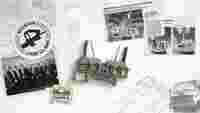The Founding of WAGO
11 March 20241980-1989

The Founding of WAGO
11 March 2024
CAGE CLAMP® Breakthrough
In the 1980s, WAGO was making great strides: CAGE CLAMP® technology was set to conquer the market. With the wind at its back, WAGO began spreading spring pressure connection technology far and wide. Driven by their absolute certainty that the market would embrace CAGE CLAMP®, the sales team became “ambassadors of spring pressure connection technology.” The product portfolio continued to expand, and licensees began using WAGO CAGE CLAMP® for device connections of their fuses, relays and sensors. In addition, CAGE CLAMP® connection technology proved its mettle in the challenging domain of “explosion protection”: with EEx e II certification, it could be used in all areas.
Product Developments and Events from the 1980s

CAGE CLAMP® Front-Entry Wiring – The Ultimate Ratio of Connection Technology
Front-entry wiring is the key to fast, safe wiring of rail-mount terminal blocks; it is also easy on the electrician. Unlike screw-type terminal blocks, there is “one conductor per clamping point” in spring pressure connection technology. The front-entry CAGE CLAMP® wiring made it possible for the first time to implement terminal blocks with 2-, 3-, 4- or more connections, as well as multilevel terminal blocks. A real customer benefit: WAGO's front-entry CAGE CLAMP® terminal blocks reduce the space required in control cabinets and even faster handling saves time and money.
1980
Safe Handling for Lay People – The WAGO Lighting Connector
In addition to a growing terminal block product portfolio, the offerings for professional installers also increased in the 80s. Starting in 1985, WAGO offered a fully insulated connector, allowing even laypersons to connect their lamps safely. How? The installer places the connector on the installation conductor, thus insulating the connection. The layperson uses the push-button to open the CAGE CLAMP® connection of the connector and can easily connect the light with any conductor type. This connector became – and remain– an enduring success.
The screwless spring-clamp terminal block was expected to take over the market. However, the path to a customer passes through many stages, and sales are met with a lot of skepticism. As in: You want to replace the proven screw-connection system? Does the spring pressure connection technology meet all quality requirements? The art of persuasion was the most necessary tool. “The market, in all its diversity, will accept us.” Encouraged by Günther Vosswinkel’s vision – he was a sales manager at the time – the sales team became “ambassadors of spring pressure connection technology.”
1982
Questions like, “Can I actuate the CAGE CLAMP® more than two times?” were raised by the skeptics. The acceptance of spring pressure connection technology remained low, and many customers and competitors continued to swear by the proven screw connections. Aid appeared again in the form of the Hanover Fair. Trade show visitors could actuate the terminal blocks as often as they wanted, which ultimately convinced them that the spring force did not degrade. The same applied analogously to the PCB terminal blocks with spring clamp connections. Skeptics say: “The actuating force of the spring is much greater for PCB terminal blocks than for screw-type terminal blocks, which is why it damages the soldering point on the PCB.” To convince these skeptics, two pressure measurement boxes were installed at the booth, and visitors could wire a screw terminal block, then a spring terminal block soldered into a PCB. The result: The actuating forces were up to 100% higher for screw-type terminal blocks than for CAGE CLAMP® terminal blocks for all participating visitors. This persuasion paid off: The market success of CAGE CLAMP® technology follows.
1985
Ex ee certificate for CAGE CLAMP® rail-mount terminal blocks
Explosion protection is the ultimate discipline for approvals – there are no more stringent requirements for rail-mount terminal blocks than this. The highly sensitive environments and associated challenges for all products in this area demand the highest levels of safety and quality. CAGE CLAMP® was approved for intrinsically safe circuits from the very beginning. With the Ex ee certificate of the CAGE CLAMP® rail-mount terminal blocks in 1985, this connection technology could serve all hazardous areas. It is the ultimate mark of quality for CAGE CLAMP® technology.
1985
Get insight into other decades of WAGO corporate history here